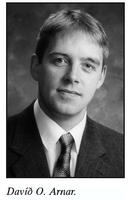Purkinje kerfi hjartans og sleglatakttruflanir við blóðþurrð og endurflæði
Davíð O. Arnar varði ritgerð sína við læknadeild Háskóla Íslands þann 7. desember 2002. Andmælendur voru prófessor Michiel J. Janse frá Amsterdamháskóla og prófessor Þórður Harðarson frá Háskóla Íslands. Heiti ritgerðarinnar er The Cardiac Purkinje System and the Ventricular Tachyarrhythmias of Ischemia and Reperfusion og byggist hún á rannsóknum sem Davíð vann undir handleiðslu James B. Martins prófessors við University of Iowa Hospitals and Clinics þegar Davíð stundaði sérfræðinám þar í hjartalækningum og hjartaraflífeðlisfræði. Hér á eftir fer enskt ágrip ritgerðarinnar.
Ventricular tachycardia (VT) and ventricular fibrillation (VF) are commonly associated with both acute myocardial ischemia and reperfusion. These arrhythmias may be due to reentry or have a focal origin where the underlying mechanism might be automaticity or triggered activity. The cardiac Purkinje system has been suspected of playing a role in the development of ischemic VT, while the subendocardium has been shown to be an important source of focal VTs during reperfusion.
Until recently the heart was thought to be devoid of postjunctional a-2 adrenoceptors. However, convincing evidence now exists that these may be present in Purkinje tissue but not myocardium in the canine species. Stimulation of these receptors prolongs the action potential duration in vitro and the Purkinje relative refractory period in vivo and thus may have a potential physiologic role.
The main goals of this investigation were twofold: 1) To examine the role of the Purkinje system in the genesis of ventricular arrhythmias of ischemia and reperfusion. 2) To further study the mechanism of Purkinje action potential prolongation seen during a-2 adrenergic stimulation and examine a potential physiologic role for these postjunctional a-2 adrenoceptors on Purkinje cells.
This investigation was undertaken using a intact, open chest, canine model where the left anterior descending coronary artery was occluded after instrumentation of the ischemic risk zone with 21 multipolar plunge needles each recording 6 bipolar electrograms. The electrograms were sampled at 3.2 kHZ and filtered from 3-1300 Hz. Three dimensional activation mapping characterized the mechanism and site of origin of VT. VT of Purkinje origin was defined as focal endocardial VT with a Purkinje potential preceding the earliest muscle activity for a given complex. Additionally, standard microelectrode studies were performed to assess the mechanism of action potential prolongation by a-2 adrenergic stimulation.
The main results suggest that the Purkinje system may be importantly involved in the initiation of both early spontaneous ischemic VT and reperfusion VT. These arrhythmias commonly have a focal origin and may be due to triggered activity from delayed afterdepolarizations, although other arrhythmia mechanisms may also play a role. The Purkinje system was also associated with the development of VT inducible with programmed extrastimulus technique in the first three hours after coronary artery occlusion. A mechanism of the a-2 adrenergic prolongation of the Purkinje action potential duration might be via inhibition of the transient outward current, Ito. In addition, these data suggest that administration of the a-2 adrenergic agonists clonidine and UK 14, 304 may selectively inhibit induction of ischemic VT of Purkinje origin only while not affecting inducibility of VT from the myocardium.
Thus, at the same time that the Purkinje system is identified to play a important role in arrhythmogenesis during acute ischemia and reperfusion the presence of a-2 adrenoceptors on Purkinje tissue might present a unique pharmacological target. Stimulation of these receptors may result in inhibition of Vt of Purkinje origin. These findings in a canine model are novel and potentially important, although further studies are needed to determine whether these results can be extrapolated to humans.

